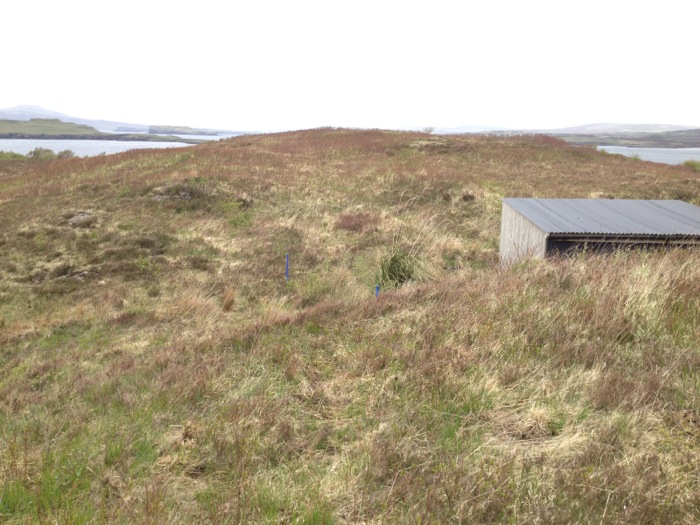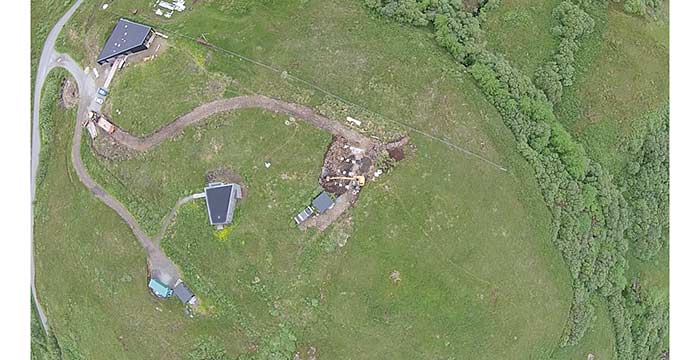Digging
First Stage Groundworks
06/06/15 18:30 Filed in: Groundworks

It took Sean about five days in total to establish a smooth track and also to scrape back the house site to the rock below the peat. This involved a day or so of rock breaking with a large hydraulic pick on the end of the 15 ton digger. The hire of Sean and the digger cost £30 an hour and £40 an hour when breaking rock. In establishing the track Sean had carefully removed the top 600mm or so of peat, complete with plants, bog myrtle, small rowan bushes and placed these carefully by the side of the track. Treating the ground in this way allows the peat and plants to survive intact.
He said we could then decide if we then want to place it back to make a smaller track to the completed house. He said he had learnt this technique while working on the large wind farms on Skye, where the contractors were strict about restricting damage to the soil and fauna. He assured us that it really works as a technique. Indeed all of the grass and shrubs are still thriving.
The rock that was broken was used to smooth and grade the track down to the house site. On the fourth day, Simon who is working with me, marked out the position of the trenches, holes for the piers upon which the building would stand. They were initially separate holes to bedrock for each pier but as Sean was excavating he found a small band of clay that needed to be dug out which then made us decide that four trenches across the width of the build would allow us a better way of setting the foundations.

Despite a survey before and a structural engineer on site this small band of clay hadn't been discovered. The trenches were deeper where the clay band had been found, this would require more concrete to get the level that we needed for all of the piers. The ground work is where costs can be unpredictable as you never completely know what you will find until the digger digs. This was not a big problem but required a solution that became four trenches with three piers across in each trench, The solution had the building on bedrock, but we would need more concrete to establish the level across the trenches. This probably increased costs at the concrete stage by £300.
The start end of May 2015
26/05/15 17:45 Filed in: Groundworks

The image above shows the track after it had been put in and the digger at work infilling around the piers. We were away when Sean began. We were only away for a day. When we arrived Sean had already created nearly the whole track down to the site. We put markers for the path to take. He put the track in a much better place that hid the road from both the Hen House and the Blackhouse. The skill of Sean is amazing to watch as he knows how the land works and how the ground can be worked by his machinery.
We had prepared people that we knew would help us on the build when we were most likely to start. We also kept in contact with them when dates began to become more fixed so that they could fit us into their other work.
We were nervous about the beginnings of the groundworks as we knew how disruptive a large earth moving digger can be and we had people staying in the Hen House through the duration of the build and we wanted not to disrupt their holidays.
We were also aware that a 90m service road would have to be constructed as the site of the Studio is tucked below a drumlin in front of the Blackhouse and to the west of the Hen House. We were also nervous about disturbing ground near to the Hen House and possibly, in some way, detracting form this building and how it relates to the land around it. I was initially reluctant to put a full width track in and said I could transport building materials over site on a quad bike. The joiner, Simon, who is working with us throughout the project from foundations to finish said this would be a bad idea. It is sometimes easy to ignore skilled people who have been involved over many years on lots of builds who know how the extra transportation of tons of material can add large amounts of wasted time to the build. I am glad that I was able to listen to his wise advice as the road has saved enormous effort in getting materials close to the building.